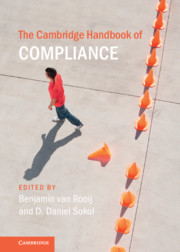Book contents
- The Cambridge Handbook of Compliance
- The Cambridge Handbook of Compliance
- Copyright page
- Contents
- Figures
- Tables
- Contributors
- 1 Introduction: Compliance as the Interaction between Rules and Behavior
- Part I Compliance Concepts and Approaches
- Part II Deterrence and Incapacitation
- Part III Incentives
- Part IV Legitimacy and Social Norms
- Part V Capacity and Opportunity
- Part VI Compliance and Cognition
- Part VII Management and Organizational Processes
- Part VIII Measuring and Evaluating Compliance
- Part IX Analysis of Particular Fields
- References
1 - Introduction: Compliance as the Interaction between Rules and Behavior
Published online by Cambridge University Press: 07 May 2021
- The Cambridge Handbook of Compliance
- The Cambridge Handbook of Compliance
- Copyright page
- Contents
- Figures
- Tables
- Contributors
- 1 Introduction: Compliance as the Interaction between Rules and Behavior
- Part I Compliance Concepts and Approaches
- Part II Deterrence and Incapacitation
- Part III Incentives
- Part IV Legitimacy and Social Norms
- Part V Capacity and Opportunity
- Part VI Compliance and Cognition
- Part VII Management and Organizational Processes
- Part VIII Measuring and Evaluating Compliance
- Part IX Analysis of Particular Fields
- References
Summary
Abstract: Compliance has become important in our contemporary markets, societies, and modes of governance across very different public and private domains, stimulating a rich body of empirical work and practical expertise. Yet, so far, we do not have a comprehensive understanding of what compliance is and what mechanisms and interventions play a role in shaping it, or how compliance shapes various fields. Thus far, the academic knowledge of compliance has remained siloed in different disciplinary domains, and along different regulatory and legal spheres and different mechanisms and interventions. This chapter, which is the introduction to The Cambridge Handbook of Compliance, offers a comprehensive view of what compliance is. It takes a broad approach in seeing compliance as the interaction between rules and behavior. It discusses what different mechanisms and interventions are at play in shaping such compliance. And it reflects on the different methods for studying compliance and their inherent limitations.
- Type
- Chapter
- Information
- The Cambridge Handbook of Compliance , pp. 1 - 10Publisher: Cambridge University PressPrint publication year: 2021
References
- 7
- Cited by

